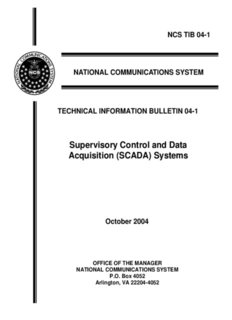Table Of ContentNCS TIB 04-1
NATIONAL COMMUNICATIONS SYSTEM
TECHNICAL INFORMATION BULLETIN 04-1
Supervisory Control and Data
Acquisition (SCADA) Systems
October 2004
OFFICE OF THE MANAGER
NATIONAL COMMUNICATIONS SYSTEM
P.O. Box 4052
Arlington, VA 22204-4052
Office of the Manager
National Communications System
October 2004
By
Communication Technologies, Inc.
14151 Newbrook Drive, Suite 400
Chantilly, Virginia 20151
703-961-9088 (Voice)
703-961-1330 (Fax)
www.comtechnologies.com
Supervisory Control and Data
Acquisition (SCADA) Systems
Abstract
The goal of this Technical Information Bulletin (TIB) is to examine Supervisory Control and
Data Acquisition (SCADA) systems and how they may be used by the National Communications
System (NCS) in support of National Security and Emergency Preparedness (NS/EP)
communications and Critical Infrastructure Protection (CIP). An overview of SCADA is
provided, and security concerns are addressed and examined with respect to NS/EP and CIP
implementation. The current and future status of National, International, and Industry standards
relating to SCADA systems is examined. Observations on future trends will be presented.
Finally, recommendations on what the NCS should focus on with regards SCADA systems and
their application in an NS/EP and CIP environment are presented.
i
ii
Table of Contents
Executive Summary..................................................................................................................ES-1
1.0 Introduction............................................................................................................................1
2.0 SCADA Overview.................................................................................................................4
2.1 Field Data Interface Devices.........................................................................................6
2.2 Communications Network............................................................................................7
2.3 Central Host Computer.................................................................................................7
2.4 Operator Workstations and Software Components.......................................................8
3.0 SCADA Architectures.........................................................................................................10
3.1 Monolithic SCADA Systems......................................................................................10
3.2 Distributed SCADA Systems......................................................................................10
3.3 Networked SCADA Systems......................................................................................12
4.0 SCADA Protocols................................................................................................................15
4.1 IEC 60870-5-101........................................................................................................15
4.2 DNP3...........................................................................................................................19
5.0 Deploying SCADA Systems................................................................................................31
5.1 Twisted-Pair Metallic Cable.......................................................................................31
5.2 Coaxial Metallic Cable...............................................................................................31
5.3 Fiber Optic Cable........................................................................................................32
5.4 Power Line Carrier......................................................................................................33
5.5 Satellites......................................................................................................................34
5.6 Leased Telephone Lines.............................................................................................35
5.7 Very High Frequency Radio.......................................................................................35
5.8 Ultra High Frequency Radio.......................................................................................36
5.8.1 Point-to-Point..................................................................................................36
5.8.2 Multiple Address Radio Systems....................................................................37
5.8.3 Spread Spectrum Radio...................................................................................38
5.9 Microwave Radio........................................................................................................38
6.0 Security and Vulnerability of SCADA Systems..................................................................41
6.1 Attacks Against SCADA Systems..............................................................................41
6.2 Developing a SCADA Security Strategy....................................................................46
7.0 SCADA Standards Organizations........................................................................................49
7.1 The Institute of Electrical and Electronics Engineers (IEEE)....................................49
7.2 American National Standards Institute.......................................................................49
7.3 Electric Power Research Institute...............................................................................50
7.4 International Electrotechnical Commission................................................................51
7.5 DNP3 Users Group.....................................................................................................52
8.0 Observations and Conclusions.............................................................................................54
9.0 Recommendations................................................................................................................55
Appendix A - Acronyms...............................................................................................................57
Appendix B - References..............................................................................................................60
Appendix C - Bibliography...........................................................................................................61
iii
List of Figures
Figure 2.1: Current SCADA Communications Media...................................................................5
Figure 2.2: Typical SCADA System..............................................................................................5
Figure 3.1: First Generation SCADA Architecture......................................................................11
Figure 3.2: Second Generation SCADA Architecture..................................................................12
Figure 3.3: Third Generation SCADA System.............................................................................13
Figure 4.1: Enhanced Performance Architecture.........................................................................16
Figure 4.2: Structure of ADSUs in IEC 60870-5-101 (1995-11...................................................19
Figure 4.3: DNP3 Client Server Relationship...............................................................................22
Figure 4.4: Common DNP3 Architectures in Use Today.............................................................24
Figure 4.5: DNP3 Layers..............................................................................................................26
Figure 6.1: Relationship Between Corporate and SCADA..........................................................46
List of Tables
Table 1.1: Matrix of NE/EP Requirements.....................................................................................2
Table 5.1: Twisted-Pair Advantages/Disadvantages....................................................................31
Table 5.2: Coaxial Cable Advantages/Disadvantages..................................................................32
Table 5.3: Fiber Optic Cable Advantages/Disadvantages............................................................33
Table 5.4: Power Line Carrier Advantages/Disadvantages..........................................................34
Table 5.5: Satellite Advantages/Disadvantages............................................................................35
Table 5.6: Leased Circuits Advantages/Disadvantages................................................................35
Table 5.7: VHF Radio Advantages/Disadvantages......................................................................36
Table 5.8: Point-to-Point UHF Radio Advantages/......................................................................37
Table 5.9: MARS UHF Radio Advantages/Disadvantages..........................................................38
Table 5.10: Spread Spectrum Radio Advantages/Disadvantages.................................................38
Table 5.11: Microwave Radio Advantages/Disadvantages.........................................................40
Table 6.1: SCADA Attack Matrix................................................................................................43
iv
Description:NCS TIB 04-1 NATIONAL COMMUNICATIONS SYSTEM TECHNICAL INFORMATION BULLETIN 04-1 Supervisory Control and Data Acquisition (SCADA) Systems October 2004

